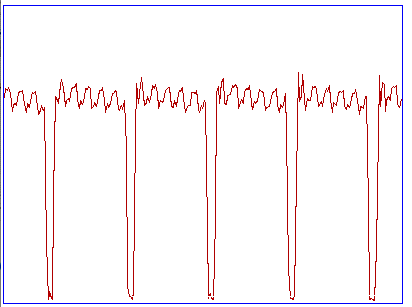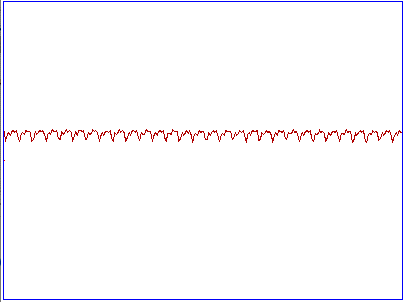
Figure: Command Transmission Noise. Two A3019 subcutaneous transmitters responding to pulses of 146-MHz command pulses. Vertical range is 27 mV, horizontal range is 500 ms. Pulses are 10 ms at 10 Hz. Pink trace: 150-mm leads. Orange trace: 45-mm leads.
If we remove the leads from an A3019, we see no response to the command transmission. We record with a two-channel Subcutaneous Transmitter (A3028D) and observe the same pulses on both channels. We suspect that the leads pick up 146-MHz power, which penetrates the transmitter circuit and is somewhere demodulated by a non-linear element in the amplifier. The demodulated signal is added to the input, resulting in pulses. We record the following trace from an A3019 without encapsulation and equipped with 150-mm wire leads.

Figure: More Command Transmission Noise. One un-encapsulated A3019 responding to pulses of 146-MHz command pulses. Vertical range is 27 mV, horizontal range is 500 ms. Pulses are 10 ms at 10 Hz.
We add a 100-kΩ resistor in series with each lead, and a 10-pF capacitor at the far side of the resistors. Thus the resistors form a high-pass filter with cut-off frequency 80 kHz. At 146 MHz, the filter attenuates by a factor of two thousand in amplitude. A 20-mV pulse of command transmission should be reduced to 1μV. With the filter installed, we recording the following trace from the subcutaneous transmitter with the same command pulses.

Figure: Eliminated Command Transmission Noise. One un-encapsulated A3019 equipped with 80-kHz low-pass filter showing no response to pulses of 146-MHz command pulses. Vertical range is 27 mV, horizontal range is 500 ms. Pulses are 10 ms at 10 Hz.
The 10-pF capacitor of the filter appears in parallel with the 10-MΩ input impedance of the subcutaneous transmitter's EEG amplifier, making a low-pass filter with cut-off frequency 1.6 kHz, which is above the 1.3-kHz bandwidth we would obtain from an A3019 running at 4096 SPS. The two 100-kΩ resistors form a divider with the 10-MΩ input impedance, which reduces the EEG signal amplitude by 2%, which is insignificant. We claim this filter will have no effect upon the detection of EEG, and yet eliminates the command transmission noise.
No comments:
Post a Comment